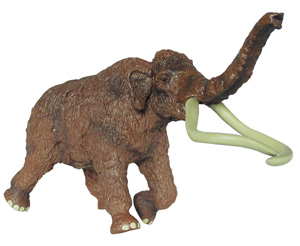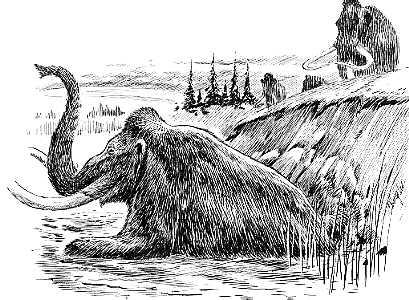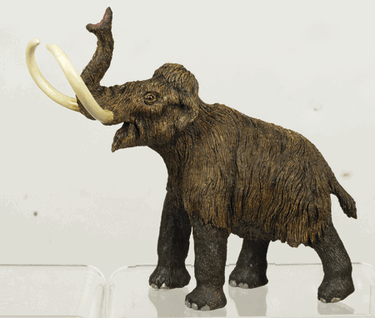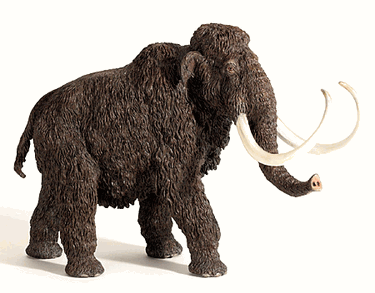Woolly Mammoths: Two Subspecies Discovered
Posted by: Loren Coleman on June 10th, 2008

Andrea Thompson, a senior writer at Live Science has written an interesting article on a new subspecies discovery regarding woolly mammoths.
Two genetically distinct groups of woolly mammoths once roamed northern Siberia, a new study suggests, with one group dying out long before humans showed up.
The finding suggests humans were not the only reason for the beasts’ demise, as some have suggested.
Scientists had long thought that woolly mammoths were one large homogeneous group, but an international group of scientists studied the mitochondrial DNA – the DNA in the genes of the mitochondria structures within cells – to paint a new picture of the ancient pachyderms.

They extracted the DNA from frozen hair samples obtained from individual woolly mammoth specimens, found throughout a wide swath of northern Siberia. They compared 18 complete genomes of mitochondrial DNA and found evidence of two genetically distinct clades, or groups of the elephant-like beasts.
The population was split into two groups, then one of the groups died out 45,000 years ago, long before the first humans began to appear in the region. This discovery is particularly interesting because it rules out human hunting as a contributing factor, leaving climate change and disease as the most probably causes of extinction. ~ Study team leader Stephan C. Schuster of Penn State University.
The research, funded by Penn State, Roche Applied Science and a private sponsor, indicates that the diversity of the two woolly mammoth groups was as low centuries ago as it is now in Asian elephants living in southern India, which has been suggested as contributing to the problem of maintaining thriving groups of Asian elephants, Schuster said.

Schuster and his team also found that each group had a low genetic diversity – in other words, individuals within each of the woolly mammoth groups were very closely related to one another.
This low genetic divergence is surprising because the woolly mammoth had an extraordinarily wide range: from Western Europe, to the Bering Strait in Siberia, to North America….[The low genetic diversity] may have degraded the biological fitness of these animals in a time of changing environments and other challenges. Study team member Webb Miller of Penn State.
In their paper, which appears in the June 9, 2008, issue of the journal Proceedings of the National Academy of Sciences, the researchers note that the smaller clade appears to have died out before the larger clade, possibly as a result of genetic drift, or the frequencies with which certain forms of a gene are passed to later generations, purely as a matter of chance. Because the population had such a small range, the lack of diversity could have left them vulnerable to a sudden change in their environment.

About Loren Coleman
Loren Coleman is one of the world’s leading cryptozoologists, some say “the” leading living cryptozoologist. Certainly, he is acknowledged as the current living American researcher and writer who has most popularized cryptozoology in the late 20th and early 21st centuries.
Starting his fieldwork and investigations in 1960, after traveling and trekking extensively in pursuit of cryptozoological mysteries, Coleman began writing to share his experiences in 1969. An honorary member of Ivan T. Sanderson’s Society for the Investigation of the Unexplained in the 1970s, Coleman has been bestowed with similar honorary memberships of the North Idaho College Cryptozoology Club in 1983, and in subsequent years, that of the British Columbia Scientific Cryptozoology Club, CryptoSafari International, and other international organizations. He was also a Life Member and Benefactor of the International Society of Cryptozoology (now-defunct).
Loren Coleman’s daily blog, as a member of the Cryptomundo Team, served as an ongoing avenue of communication for the ever-growing body of cryptozoo news from 2005 through 2013. He returned as an infrequent contributor beginning Halloween week of 2015.
Coleman is the founder in 2003, and current director of the International Cryptozoology Museum in Portland, Maine.










This low genetic divergence is an interesting subject for our favorite cryptid: Sasquatch.
How many specimens would here have to be to mantain a healthy population with enough genetic diversity to withstand enviromental changes?
Nice link to the mammoth findings.
As to Sasquatch, red pill presents a good question.
I think it may be also an argument against the existence of Sasquatch. Insufficient numbers (as per sightings, or sightings of footprints, or any type of documentary evidence, as compared as to what one would have for such rare creatures as javan rhinos, or snow leopards, or Yangtze porpoises) to have a viable population, over the exceptionally wide distribution area (west coast to east coast for Sasquatch) claimed for it.
I would like to have some comment on any super rare creature verified to exist as having a range that covers three time zones.
Doesn’t mean that Sasquatch doesn’t exist. It means that the evidence currently accumulated for proof of its existence isn’t sufficient.
How many verified, authentic photos do we have of the creature (not footprint casts–I mean of the actual creature)? How many verified, authentic films?
Let’s say we have a 100 years worth of eyewitness reports, for the sake of the argument. But we still don’t have any concrete proof. (Yes, I am aware that a number of researchers have stool samples in deep freeze that is alleged from Sasquatch. Has any of that been tested?)
Figure it out.
In any event its nice to know that we humans were not totally responsible for the mammoths extinction. Ma Nature got this one all by herself.
Could it be that the only variations of the Mammoth existing is the modern elephant? India and Africa leave them alive yet in warmer climates causing them to lose hair and adapt to their environments. May not have been separate animals yet evolved to what we now know of? As far as Squatches go, get me the funding to catch one, alive or dead.
It won’t be cheap, but I’m sure I can do it. It’s the funding of Helicopter, cage, time and other resources. Those who look for these animals usually don’t have the funds to catch one alive. Oh, they are there, cause I have seen one, no doubt. Like others in the crypto field, we just ain’t got the cash. It’ll be a big production.
It’s becoming more and more likely that the primary cause of the mammoth’s demise, as well as the other 23 genera of megafauna at that point in the planet’s history was the result of impact with a comet somewhere over the Laurentian ice field 12.9KYA. There is much evidence supporting this and fewer and fewer arguments to refute it.
The good news is that ecological restoration efforts and advances in DNA engineering are opening-up possibilities of one day seeing these incredible examples of genetic diversity once again in natural settings.
Dogu4- Yes indeed. Some of the projects planned for restoring these prehistoric habitats, like the Pleistocene Park in Siberia which proposes to create a full mammoth steppe ecosystem, are truly vast in scope. Seeing a herd of mammoths in their natural setting would be a breathtaking sight.
I’ve heard of that Mystery Man and hope to visit it, Pleistocene Park, someday if I get to make my grand tour., but in case I don’t I’m totally enthralled with the idea of re-creating the pleistocene ecosystem of the American Southwest, the Mojave and Sonoran deserts in particular, where today there is plenty of room (public land) and the current inventory is clearly impoverished of its potential due to that 12.9KYA Clovis extinction event. Some restoration conservation biologists are suggesting that small scale experiments in conservation begin using surrogates: asian elephants (THE number one keystone species, which even today are being kept in big fenced-in sanctuaries when zoos and circuses have to give them up), camels (almost made it back in the 1890s…should have used bactians)), zebras (we already have reintroduced 2 other equine species), cheetahs (pronghorns’ original natural control predator), african lions and giant tortoises (a surprisingly effective browsing/grazing animal only recently extirpated). There are entire communities of native plants and animals whose populations are merely waiting for the return of the critical components of the American Serengeti, and whether they’re surrogates or not they would also serve as reserve populations should their cohort source populations suffer a catastrophe in their future…something that become all the more of a concern as wild populations are shrinking everywhere and becoming more vulnerable to exactly those kinds of devastation and genetic bottlenecking.
As the firesign theater saying goes; forward into the past!
Cheers.
Great article, as usual, Loren.
I would also love to see “restored” Mammoths in their natural habitat.